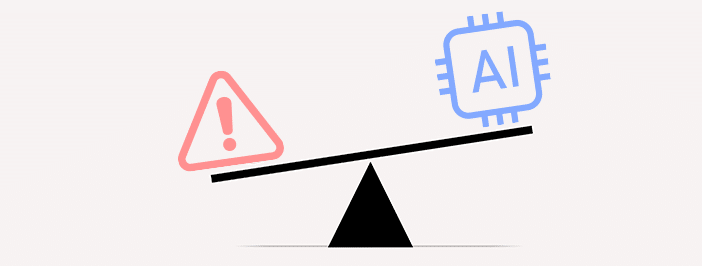How to Balance AI’s Benefits and Security Risks in Cybersecurity
Artificial intelligence (AI) is transforming cybersecurity, helping businesses detect threats and automate responses. But while AI strengthens security, it also introduces AI security risks—such as being exploited by hackers or making incorrect decisions that leave businesses vulnerable.
So, how can you harness the power of AI in cybersecurity while mitigating its risks? The key is balance. AI is a tool—not a replacement for human expertise. Understanding the benefits and the risks of AI in cybersecurity is essential for building a strong, resilient defense. Let’s break it down.
The Benefits of AI in Cybersecurity
AI is reshaping cybersecurity by improving how businesses detect, prevent, and respond to cyberthreats. Here’s how AI strengthens security operations:
1. Faster Threat Detection and Response
Cyberattacks are becoming more sophisticated, and businesses can’t afford to wait hours—or even minutes—to detect and respond to threats. AI-powered security tools analyze massive amounts of data in real-time, recognizing attack patterns before they cause harm.
For example, AI-driven Security Information and Event Management (SIEM) systems monitor networks 24/7, identifying unusual behavior and potential breaches within seconds. AI can detect patterns of cyberattacks that traditional security tools might miss.
2. Reducing Human Error in Security
Even the most skilled security teams can make mistakes—especially when dealing with overwhelming amounts of data and alerts. AI helps by automating repetitive security tasks, such as identifying phishing emails, analyzing system logs, and detecting anomalies in network traffic.
This automation reduces the risk of human error, one of the leading causes of data breaches. A recent report by Verizon found that 64% of data breaches involved a non-malicious human element. By augmenting security teams with AI, businesses can ensure threats are detected accurately and consistently.
3. Strengthening Endpoint and Network Security
With the rise of remote work and cloud computing, businesses now operate in a more complex digital environment. AI can help secure endpoints (such as laptops and mobile devices) by detecting malware, monitoring login patterns, and enforcing security policies in real-time.
AI-powered network security tools can also flag unusual traffic patterns that indicate a potential data breach or ransomware attack. By continuously analyzing network activity, AI helps businesses stay proactive rather than reactive.
Understanding AI Security Risks: Where AI Can Go Wrong
For all the benefits AI brings to cybersecurity, it could also introduce significant risks. If AI is misused or misunderstood, businesses can find themselves vulnerable to cyberthreats rather than protected from them.
1. AI Being Used by Hackers
One of the most significant AI security risks is its misuse by cybercriminals. Hackers are leveraging AI to enhance and automate their attacks.
Cybercriminals are using AI to:
- Create sophisticated phishing attacks: AI can generate convincing fake emails that mimic real communication, making it harder for employees to spot scams.
- Bypass security defenses: AI-powered malware can continuously evolve, changing its behavior to avoid detection by traditional security tools.
- Launch automated cyberattacks: AI can scan the internet for vulnerabilities and exploit them faster than human hackers ever could.
A recent example is the rise of deepfake technology, where AI-generated voices and videos are used for fraud and misinformation.
2. AI Could Make Incorrect Security Decisions
AI models are only as good as the data they’re trained on. If an AI security system is fed incomplete, biased, or outdated data, it may make incorrect decisions—leading to both false positives and false negatives.
Some potential issues include:
- Blocking legitimate users or transactions: AI-powered fraud detection systems have mistakenly flagged actual customer transactions as fraudulent, causing financial and reputational damage.
- Failing to recognize new threats: If an AI model hasn’t been trained on the latest cyberthreats, it may fail to detect those attacks, leaving businesses vulnerable.
How to Use AI in Cybersecurity Responsibly
To maximize AI’s benefits while minimizing risks, businesses need to use AI as a supporting tool rather than a standalone solution. Here’s how:
1. Combine AI with Human Oversight
AI can detect threats at machine speed, but human expertise is still essential. Security teams should use AI as an assistant—not a replacement.
- Automate routine tasks: Let AI handle repetitive security monitoring so that human analysts can focus on complex threats.
- Keep humans in the decision-making loop: AI can flag potential threats, but humans should review critical security alerts before action is taken.
- Train employees on AI-driven threats: Since attackers are using AI, businesses need to educate employees on recognizing AI-generated phishing scams and fraud attempts.
2. Test AI Security Tools for Effectiveness
Not all AI security tools are created equal. Businesses should rigorously test AI-driven security solutions before deploying them.
- Simulate real-world attacks: Conduct penetration testing to see how well the AI tool detects and responds to threats.
- Monitor for false positives and negatives: If AI is blocking legitimate users or missing actual threats, adjustments are needed.
- Regularly update AI models: AI security tools need ongoing updates to stay ahead of emerging cyberthreats.
AI is Powerful, But It’s Not Perfect
AI is a powerful tool, but businesses must approach it strategically to avoid AI security risks. Without proper oversight, AI can become a liability instead of an asset. The key is balance—leveraging AI while maintaining human control.
At GB Tech, we help businesses navigate the complexities of AI and cybersecurity. Whether you need help evaluating AI security tools, improving threat detection, or building a resilient security strategy, our team is here to guide you. Reach out today to ensure your AI-driven security strategy is rock solid.























